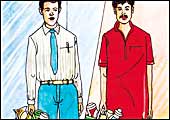 |
MYTH The
small town customer is a clone of a big city one
REALITY: Media habits are different
in small towns and so are shopping habits |
 |
MYTH Small
town customers cannot appreciate sophisticated ads
REALITY: Small town consumers
need more convincing. Over simplification of ads doesn't help.
And even vern has its limits |
Is
the consumer in small town India any different from her big city
brethren? Well, yes and no. And in between this yes and no, a thousand
marketing myths abound.
For instance, though the socio-cultural-economic
realities of a small town do make for some peculiar consumption
quirks, such as a preference for small-packs in consumer staples
such as tea, toothpaste and detergents, the average resident of
a small town isn't really a small-pack consumer. "Low unit
packs sell in these markets, not low prices. Consumers here are
more brand conscious than their big city counterparts," says
C.K. Ranganathan, Chairman & Managing Director, CavinKare.
And when it comes to aspirations for a better
product, service, lifestyle or career, why should the small towner
be any different from the big city dweller? Unfortunately, marketers
who are yet to catch up with small town realities erroneously caricature
the consumers there as extremely price-driven, brand-fickle, and
ill-informed; and often as semi-educated buffoons in awe of any
advertising that uses vern taglines to convey over-simplified brand
messages.
"The biggest mistake most marketers make
is to assume that the small town consumer is merely a clone of the
big city consumer," says Atul Sobti, Senior Vice President
(Sales & Marketing), Hero Honda. And that the only difference
between them is the money they have at their disposal. Nothing could
be farther from truth.
 |
MYTH Small
town customers are credit shy
REALITY: Don't blame the small-towners,
blame the lack of organised credit |
 |
MYTH Young
people in small towns are less informed than their big city
brethern
REALITY: You couldn't be more
wrong. They are as well-informed as their big city counterparts |
Take media habits, for instance. It is often
taken for granted that people in small towns, with more time to
spare because they spend less time commuting, watch more television
compared to what people in Delhi or Mumbai do. Viewership data from
television monitoring agency TAM for April-June 2004 in the Hindi-speaking
markets reveal that individuals in a small town (1 lakh-10 lakh
population) watch just 116 minutes of television per day compared
to 131 minutes for a metro and 128 minutes for a city with a population
in excess of a million. And fewer individuals watch mass entertainment
channels, like Star Plus and Zee in smaller towns-a mere 47 per
cent compared to 53 per cent in the metros.
Another commonly held misconception about the
small town consumer is that she is the exact opposite of her urban
counterpart. The notion that small town consumers necessarily go
in for lower priced products has been a recipe for many a marketing
disaster. In a study of affluent consumer across big metros (Delhi,
Mumbai, Kolkata, Chennai, Bangalore and Hyderabad) and small metros
(such as Patna, Coimbatore, and Vishakapatnam), research agency
ACNielsen India found that small town consumers were in step, and
very often a step-ahead, of consumers in metros.
More consumer households in small towns owned
second homes (19 per cent compared to 13 per cent in the metros),
laser discs (27 per cent to 22 percent), branded readymade garments
(45 per cent to 42 per cent), and four-wheelers (92 per cent to
83 per cent). "Though for us (the FMCG marketers) the market
has stagnated, durables that are aspirational have a huge market
to tap in smaller, sub-million population towns because they have
the money," says Geogi E. Zachariach, Head, Alembic Consumer
Healthcare. What small town consumers are looking for is a good
value proposition and not just low price. And new marketers such
as LG or Samsung who do not have the mental baggage of such myths
have grasped this, for they are not playing on price alone, and
have succeeded in storming the Indian market, their latest success
being in the smaller towns.
 |
MYTH Small
town customers do not have global aspirations
REALITY: Even a cursory look at
the sheer number of people migrating to foreign countries or
big cities for education or employment shows otherwise |
Among motorcycles, Hero Honda's Passion, coming
at almost a Rs 2,000 premium to Splendor, has started to sell well
in small town markets, points out Sobti as proof that style, aspirations
and generally better quality (even at a higher price), has its takers
even in the smaller towns. "And all this while it was more
a problem of non-availability of organised finance, not credit shyness
from consumers' viewpoint, because big players here would not finance
beyond an area 10 km in radius," adds Sobti. Or they would
have huge exclusion lists based on profession, for many big consumer
financiers underestimated the small town consumers' capacity to
repay simply because she was more often than not self-employed.
Credit cards and home loans, two categories that have broken this
myth, have seen their takings skyrocket from these towns, Rs 4,550-crore
(spending) for credit cards (outside metros) and Rs 35,000-crore
for home loans (outside top 20 cities).
But surely, the kids and teens in small towns
must be less aware compared to Delhi or Mumbai youth? Wrong again,
for viewership in metros and small towns mirror each other for awareness
and attitude building vehicles such as news, sports, English movies
and entertainment and kids channels, according to TAM figures for
April-June 2004 for cable and satellite households. Sports channels
were watched by 1 per cent of metro viewers, the same as small towns.
Music channels by 3 per cent in metros as well as small towns. Even
English entertainment channels such as Star World, Zee English,
and AXN have an identical, 1 per cent share of viewership in the
two categories.
 |
MYTH Small
town customers buy products in small sizes
REALITY: Awareness that small
packs are actually more expensive is much higher in small towns.
Where they can afford it, small town consumers go in for big
pack sizes |
 |
MYTH Small
town customers are obsessed with price, price, and price
REALITY: Consumers with equal
amount of money in small towns buy more expensive products compared
to big-city consumers |
Similarly, there is a false assumption of a
communication gap between the moderator (large-town marketer) and
the respondent (small-town consumer) that is belied by the realities
on the ground. "The biggest myth is to assume that small town
is a different mass and that we need a Hindi or vern baseline for
it," says Partha Sinha, Executive Vice President, Ambience
Publicis. The fact is that a Hindi or vern baseline is needed as
much for the big city as it is for the small city, for huge pockets
within metros such as Delhi, Kolkata, Mumbai and Chennai exhibit
population psychographics that have semi-urban, if not rural, characteristics.
"The small town consumer is more intelligent
than most admit when it comes to comprehending ads. She is still
not desensitised, unlike metro consumers," says Harish Bijoor,
who runs an epnoymous marketing consultancy. While conducting a
study for a foreign marketer entering the Rs 20,000-crore consumer
durable industry, Bijoor Consults found that ephemeral product claims
in advertising (such as the one where a television works wonders
for your body) were literally scorned by the small town consumer.
"One rule that works across big and small towns is simple and
straightforward advertising," adds CavinKare's Ranganathan.
The legendary marketing guru Orvel Ray Wilson
once said, "Customers buy for their reasons, not ours."
Indian marketers would do themselves a service if they kept small-town
'reasons' in mind, much the way Electrolux Kelvinator kept the precarious
power supply in small towns in mind when it launched its aptly named
battery-powered refrigerator Bijlee, rather than being blindly guided
by the old discredited myths about small towns.
|
